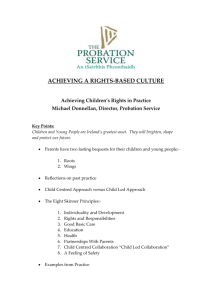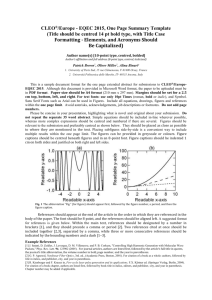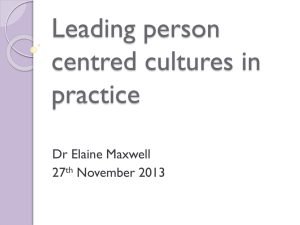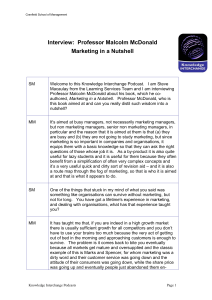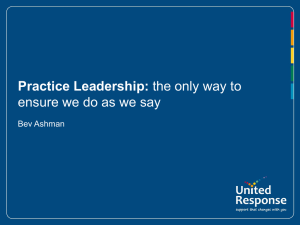Interview: Professor Mark Jenkins Customer Centred Strategy: Thinking Strategically About Your Customers
advertisement
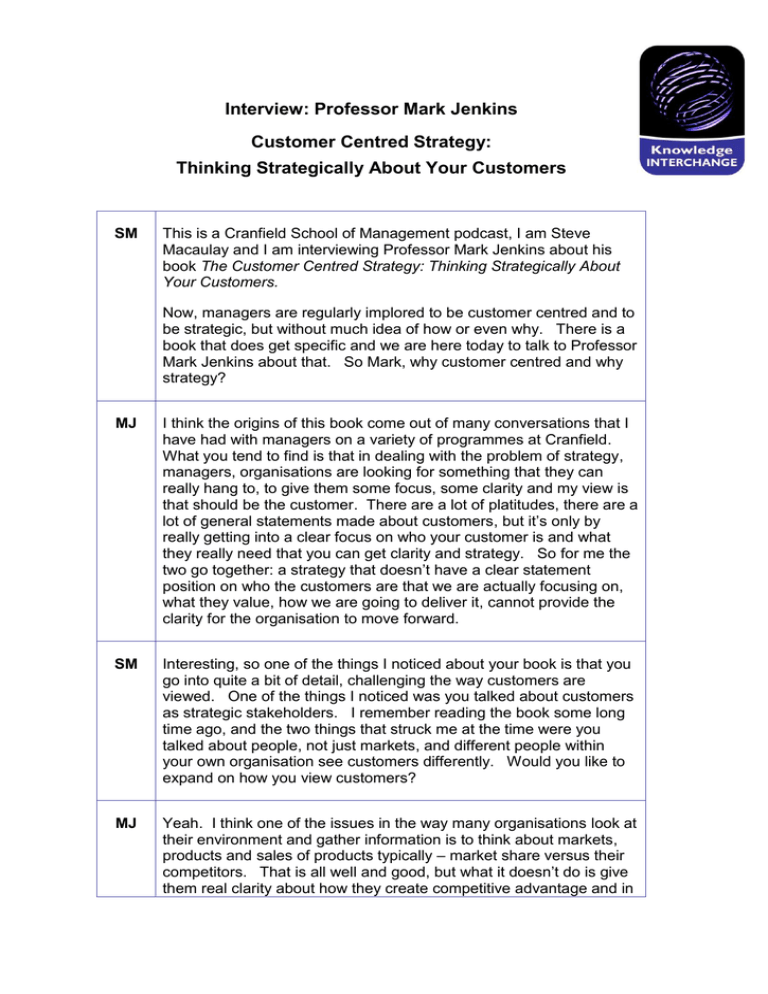
Interview: Professor Mark Jenkins Customer Centred Strategy: Thinking Strategically About Your Customers SM This is a Cranfield School of Management podcast, I am Steve Macaulay and I am interviewing Professor Mark Jenkins about his book The Customer Centred Strategy: Thinking Strategically About Your Customers. Now, managers are regularly implored to be customer centred and to be strategic, but without much idea of how or even why. There is a book that does get specific and we are here today to talk to Professor Mark Jenkins about that. So Mark, why customer centred and why strategy? MJ I think the origins of this book come out of many conversations that I have had with managers on a variety of programmes at Cranfield. What you tend to find is that in dealing with the problem of strategy, managers, organisations are looking for something that they can really hang to, to give them some focus, some clarity and my view is that should be the customer. There are a lot of platitudes, there are a lot of general statements made about customers, but it’s only by really getting into a clear focus on who your customer is and what they really need that you can get clarity and strategy. So for me the two go together: a strategy that doesn’t have a clear statement position on who the customers are that we are actually focusing on, what they value, how we are going to deliver it, cannot provide the clarity for the organisation to move forward. SM Interesting, so one of the things I noticed about your book is that you go into quite a bit of detail, challenging the way customers are viewed. One of the things I noticed was you talked about customers as strategic stakeholders. I remember reading the book some long time ago, and the two things that struck me at the time were you talked about people, not just markets, and different people within your own organisation see customers differently. Would you like to expand on how you view customers? MJ Yeah. I think one of the issues in the way many organisations look at their environment and gather information is to think about markets, products and sales of products typically – market share versus their competitors. That is all well and good, but what it doesn’t do is give them real clarity about how they create competitive advantage and in Customer Centred Strategy my view that can only be achieved by getting this clear focus on who these customers are, where they sit, where they live and what it is they value. And so it is moving to that extra level of detail, away from focusing on market share, away from focusing on competitors to say let’s really be clear, what is it that our customers are really looking for and how can we deliver that, and how can we deliver that better than the competition? SM One of the things you do is offer some descriptions of tools and frameworks that companies can use to help them achieve that. I remember there was one called customer matrix – would you like to expand on some of these just to give the listeners some thoughts about that? MJ Yes. Essentially the book covers a number of different tools drawn from different areas – some have been developed at Cranfield, others not. But all really help this clarity and this focus on the customers. The customer matrix is a good example of that – it essentially starts from the customer’s perspective: how does the customer see the world? And it splits out the value for money dimensions into the value dimension and the money dimension. In other words, as a customer, what value am I going to derive from acquiring this product and what price do I have to pay to acquire it? And if you think about that as a landscape of positioning competitors and also defining our strategy, it gives us a sense of where we are, where we are trying to move to. But in order to do some useful analysis and some useful thinking on the customer matrix, you have to be clear as to who your customer is. SM Now, one of the things that you talked about in the book is that managers should consider not just today’s customers, but tomorrow’s and one of the things that I saw in the book was about scenario planning. Now I have always held, maybe wrongly, a view of scenario planning that it’s something the likes of Shell do and it’s a very complicated process. Could you expand on just what you see it is and what you see it can be to companies? MJ Well, I think scenario planning is a generic approach to help you think different possible futures. The level at which you apply that depends on your business. Clearly someone like Shell in the global petroleum, global energy business, is going to take a very wide view on that in terms of growth, global changes, technologies, political influence – all those factors. What I am suggesting is, as we start to think about our customers more specifically, scenario planning actually helps us again think about different possibilities for those customers – who the future customer might be, what it is that they are going to look for. So I am using the principles of the technique Knowledge Interchange Podcasts Page 2 Customer Centred Strategy but applying it in a more focused way around the customer and what it is we think they are going to be looking for in the future. SM One of the areas that you explore in the book is looking at the competencies of the organisation and what it can actually deliver and then balancing that out with the needs of the customer. Can you say a bit more about that? MJ Yes. I mean, essentially, one of the challenges in following the customer is you have got to follow it in a way that is going help you create advantage. So, maybe customers all want a certain kind of product, but it may be that you cannot produce that product as well as your competitors, but you can produce a slightly different product that appeals to a niche group of those customers. So it’s about alignment. It’s finding those areas where you have an advantage, that it’s more difficult for your competitors to compete with you, and that can be done by being clear about your own specific competencies and aligning those with groups of customers who are going to value what you do. SM Would you see people being able to do that on their own – it feels a bit academic in a way, some of these tools . It’s very well us sitting in here in an ivory tower world, but a manager on the spot, are they able to pick up some of these? MJ Absolutely. I think all strategy tools for me are thinking tools. They are not black box tools – you put the data in and it gives you an answer. The problem with strategy is that managers have to make sense of a situation and to analyse and synthesise the data, and then find a way forward – a strategy that they can follow. So it’s about helping them think about their situation, challenging some of their accepted wisdoms to say well perhaps there are different ways of thinking about these things. So every tool has to challenge, but has to provide a basis for people to discuss, think through, articulate, develop logic and that is exactly what these frameworks do. So it may be an individual can work through it, it may be a group of individuals, but what is important is that it provides a common language for those debates. SM Now you have got years of experience of working with organisations, using these tools. Are there any companies that stand out and you can say, well they seem to be doing what I have just talked about and that seems to be working well? Knowledge Interchange Podcasts Page 3 Customer Centred Strategy MJ Yeah. I think some of the great examples recently are companies like Tescos in the retail sector, who have been able to use a lot of the data they collect from Clubcard and so on to be very targeted in terms of the segments that they work through. Interestingly you also see it in areas like mobile phones. A company like T-Mobile have focused on some of their potential weaknesses. One of the problems with their network is that it doesn’t work so well in rural areas so their market segmentation has been focusing on younger teenagers in cities, which differentiates them slightly from other companies – their competitors like Vodafone and O2 – by focusing on this segment and building a strategy that focuses on the segment and therefore creates advantage in that area. SM Now, the book came out in the late 90s and the world has moved on since then – have you seen changes in this area? Are we more customer centred, are we more strategic? MJ I think we have more of the trappings of being customer centred, for example, technologies in CRM, customer service work – all these sort of areas. So I think the language has become more sophisticated, the tools have become more sophisticated, but I still see that fundamental challenge of how you embed that kind of ethos in the organisation. I think organisations are still grappling with that. And of course the other problem is in many markets that speed of change is increasing. So, actually trying to get clarity and adaptability in a way that you look at your customers is an increasing challenge for organisations. SM So, finally, I would like you to give some advice to the average manager that might read this book – are there any tips and traps that you might want to point out? MJ I think for me the critical piece in this book is to say to a manager reading it, believe in yourself, believe in the data and instincts that you have. What this book does – it doesn’t give you answers, but it helps you think through issues and make decisions. At the end of the day, the individual still needs to make a decision. Someone needs to say yeah, this is the way we are going to go and build the commitment around that. So don’t feel you have to have all the data, all the answer before you make a decision and you find a path forward. I think increasingly managers have got to synthesise a situation, take really imperfect information but find a way forward and really stick to that and I think that is the challenge that is facing most managers today. This book is not a set of answers, it’s a way to help think and craft conversations around customers and I think that Knowledge Interchange Podcasts Page 4 Customer Centred Strategy is the way to take it forward. SM One of the things that struck me in the book is about challenging your own assumptions about customers – do you want to say anything about that? MJ Yeah. I think as organisations change, as customers change, what you sometimes find is that an organisation is built around – the products, the approaches – are built around a customer that no longer exists. I always remember a company I used to work for in agricultural machinery where essentially the product manager designed a tractor in this case, around his brother in law who was a farmer, and everything ended up being designed really based on that kind of customer. But of course the markets move on, the kind of practices move on. So one of the challenges is being clear about who actually is the customer that is informing our decisions and how do we ensure that we are moving forward with that customer, rather than essentially serving a customer in our minds that is really ten, fifteen years out of date. SM It’s a very important point. Thank you very much. We have had a very useful look through at some key areas. Thank you. MK Thank you. Knowledge Interchange Podcasts Page 5 Cranfield School of Management Produced by the Learning Services Team Cranfield School of Management © Cranfield University 2008
